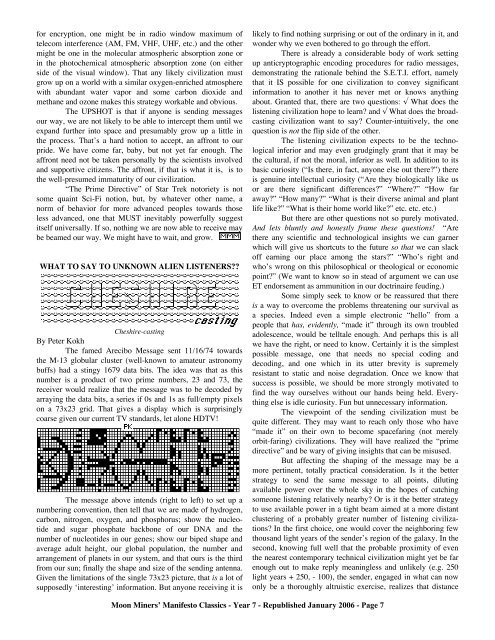MMM Classics Year 7: MMM #s 61-70
MMM Classics Year 7: MMM #s 61-70
MMM Classics Year 7: MMM #s 61-70
- No tags were found...
You also want an ePaper? Increase the reach of your titles
YUMPU automatically turns print PDFs into web optimized ePapers that Google loves.
for encryption, one might be in radio window maximum oftelecom interference (AM, FM, VHF, UHF, etc.) and the othermight be one in the molecular atmospheric absorption zone orin the photochemical atmospheric absorption zone (on eitherside of the visual window). That any likely civilization mustgrow up on a world with a similar oxygen-enriched atmospherewith abundant water vapor and some carbon dioxide andmethane and ozone makes this strategy workable and obvious.The UPSHOT is that if anyone is sending messagesour way, we are not likely to be able to intercept them until weexpand further into space and presumably grow up a little inthe process. That’s a hard notion to accept, an affront to ourpride. We have come far, baby, but not yet far enough. Theaffront need not be taken personally by the scientists involvedand supportive citizens. The affront, if that is what it is, is tothe well-presumed immaturity of our civilization.“The Prime Directive” of Star Trek notoriety is notsome quaint Sci-Fi notion, but, by whatever other name, anorm of behavior for more advanced peoples towards thoseless advanced, one that MUST inevitably powerfully suggestitself universally. If so, nothing we are now able to receive maybe beamed our way. We might have to wait, and grow.WHAT TO SAY TO UNKNOWN ALIEN LISTENERS??Cheshire-castingBy Peter KokhThe famed Arecibo Message sent 11/16/74 towardsthe M-13 globular cluster (well-known to amateur astronomybuffs) had a stingy 1679 data bits. The idea was that as thisnumber is a product of two prime numbers, 23 and 73, thereceiver would realize that the message was to be decoded byarraying the data bits, a series if 0s and 1s as full/empty pixelson a 73x23 grid. That gives a display which is surprisinglycoarse given our current TV standards, let alone HDTV!The message above intends (right to left) to set up anumbering convention, then tell that we are made of hydrogen,carbon, nitrogen, oxygen, and phosphorus; show the nucleotideand sugar phosphate backbone of our DNA and thenumber of nucleotides in our genes; show our biped shape andaverage adult height, our global population, the number andarrangement of planets in our system, and that ours is the thirdfrom our sun; finally the shape and size of the sending antenna.Given the limitations of the single 73x23 picture, that is a lot ofsupposedly ‘interesting’ information. But anyone receiving it islikely to find nothing surprising or out of the ordinary in it, andwonder why we even bothered to go through the effort.There is already a considerable body of work settingup anticryptographic encoding procedures for radio messages,demonstrating the rationale behind the S.E.T.I. effort, namelythat it IS possible for one civilization to convey significantinformation to another it has never met or knows anythingabout. Granted that, there are two questions: √ What does thelistening civilization hope to learn? and √ What does the broadcastingcivilization want to say? Counter-intuitively, the onequestion is not the flip side of the other.The listening civilization expects to be the technologicalinferior and may even grudgingly grant that it may bethe cultural, if not the moral, inferior as well. In addition to itsbasic curiosity (“Is there, in fact, anyone else out there?”) thereis genuine intellectual curiosity (“Are they biologically like usor are there significant differences?” “Where?” “How faraway?” “How many?” “What is their diverse animal and plantlife like?” “What is their home world like?” etc. etc. etc.)But there are other questions not so purely motivated.And lets bluntly and honestly frame these questions! “Arethere any scientific and technological insights we can garnerwhich will give us shortcuts to the future so that we can slackoff earning our place among the stars?” “Who’s right andwho’s wrong on this philosophical or theological or economicpoint?” (We want to know so in stead of argument we can useET endorsement as ammunition in our doctrinaire feuding.)Some simply seek to know or be reassured that thereis a way to overcome the problems threatening our survival asa species. Indeed even a simple electronic “hello” from apeople that has, evidently, “made it” through its own troubledadolescence, would be telltale enough. And perhaps this is allwe have the right, or need to know. Certainly it is the simplestpossible message, one that needs no special coding anddecoding, and one which in its utter brevity is supremelyresistant to static and noise degradation. Once we know thatsuccess is possible, we should be more strongly motivated tofind the way ourselves without our hands being held. Everythingelse is idle curiosity. Fun but unnecessary information.The viewpoint of the sending civilization must bequite different. They may want to reach only those who have“made it” on their own to become spacefaring (not merelyorbit-faring) civilizations. They will have realized the “primedirective” and be wary of giving insights that can be misused.But affecting the shaping of the message may be amore pertinent, totally practical consideration. Is it the betterstrategy to send the same message to all points, dilutingavailable power over the whole sky in the hopes of catchingsomeone listening relatively nearby? Or is it the better strategyto use available power in a tight beam aimed at a more distantclustering of a probably greater number of listening civilizations?In the first choice, one would cover the neighboring fewthousand light years of the sender’s region of the galaxy. In thesecond, knowing full well that the probable proximity of eventhe nearest contemporary technical civilization might yet be farenough out to make reply meaningless and unlikely (e.g. 250light years + 250, - 100), the sender, engaged in what can nowonly be a thoroughly altruistic exercise, realizes that distanceMoon Miners’ Manifesto <strong>Classics</strong> - <strong>Year</strong> 7 - Republished January 2006 - Page 7















